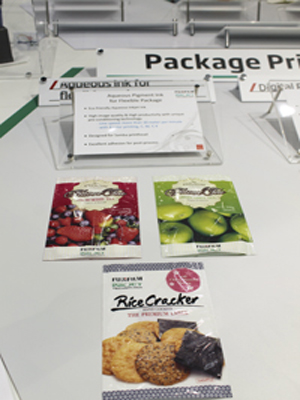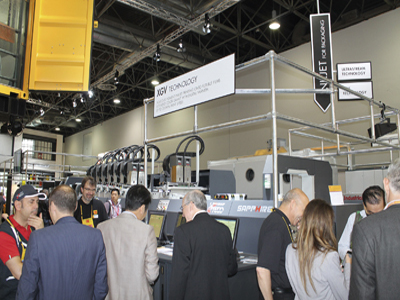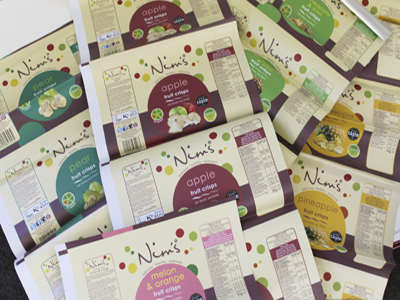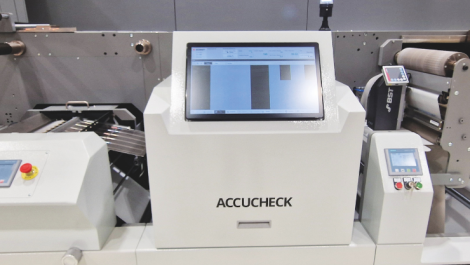Nim’s Fruit Crisps packaging printed by Ultimate on its HP Indigo 20000
Printing flexible packaging with digital is on the rise, but it is not without its challenges. Up until now, the sector has been dominated by narrow web electrophotography, but several suppliers have introduced mid-web sized inkjet presses to get a bite of the vast flexible packaging market. By Neel Madsen.
Shorter runs lengths and demand for multiple SKUs have opened up the flexible packaging market for digital printing. But the difficulty of printing on thin, unsupported filmic material and the huge variety of substrates pose a very serious challenge to press manufacturers and printers alike. Compliance is another problem for those wishing to print for the food packaging sector.
Paving the way
HP Indigo went wider with the 20000 model digital press for labels and packaging early on at drupa 2012, and the press won the 2015 European Digital Press Award for best packaging solution. The judges said, ‘This webfed version of HP Indigo’s wider press platform, first seen in the sheetfed 10000, enables a wide range of new applications for the digital printing of packaging on flexible substrates beyond the label markets where it has been predominant to date.’
Printing on substrates from 10 to 250 microns, it has a web width of 762 mm (740 x 1100 mm image format) and prints in seven colours using HP’s ElectroInks, including the latest introductions: fade-resistant yellow and magenta, special white for sleeves and fluorescent pink. The speed is up to 42 m/min.
As one of the beta test sites, Ultimate Group, in Grimsby, first installed an HP Indigo 20000 in 2014. It works with many of the leading brands and supermarkets in the UK and Europe, including Iceland, M&S and Waitrose, to produce digitally printed packaging.
Owner and executive director Chris Tonge has always been very clear about the advantages of digital. At a recent roundtable event on flexible packaging held at Parkside Flexibles, he said, ‘All the flexo print done by Ultimate is for the UK market, whereas digital has taken us into Europe. Digital is not eating into our flexo business significantly in terms of volume, but we have some very interesting accounts. We have not moved one job from flexo to digital though. Digital is about doing something completely different.’
Mr Tonge noted that the majority of large brand owners have now signed up to digital flexible packaging. ‘Most of what we want to print, we can print digitally now,’ he said. He also said that selling digital is very different to selling flexo print. Digital has to be sold to the marketers not the print buyer as it is not about the price, whereas flexo is traditionally sold only on price, at very low cost, but with demands for exceptional quality, leaving little margin for high profit.
For the brands and retailers, the possibilities with digital are endless. Karen Graley, who is the packaging and reprographics manager at Waitrose and one of Ultimate’s customers, said, ‘We are exploring new formats and pack sizes, and we can respond and bring new products to market more quickly. Digital packaging has also opened up the possibilities of ‘at store’ packaging for real time packaging delivery.’
New on the market
Following the same development pattern as we have seen in labels, the next wave of presses for packaging applications uses inkjet technology and there are now great advances being made in both UV- and water-based inkjet. As a non-impact print method, inkjet technology lends itself well to the multitude of different substrates used for flexible packaging applications, be they bags, pouches, sachets or lids for trays.
Fujifilm has chosen to launch its new MJP20W EUCON UV inkjet press to the Japanese market first. This is based on a collaboration with Miyakoshi and utilises ‘Enhanced Under Coating and Nitrogen purging’ (EUCON) technology to reduce UV ink odour.
The press can print on 12-100 micron PET, 25 micron OPP and 15 micron nylon, using UV LED curing at speeds up to 50 m/min. It uses Fujifilm’s Uvijet inks (CMYK+W) and has a print width of 541 mm. The resolution is 600 dpi, but the company is aiming to take this up to 1200 dpi.
Peter Verryt, packaging segment manager, Graphic Systems Europe, said, ‘Fujifilm’s new high productivity flexible packaging press, the MJP20W, was introduced at drupa 2016 as a product for the Japanese market and it remains the case that Fujifilm is not selling this press outside of Japan. One of Fujifilm’s goals at drupa was to get confirmation on European market requirements and thanks to the high level of interest the machine received, we were able to get this feedback and are using it to further outline current and future customer expectations.’

Fujifilm packaging printed with newly developed
water-based inks
Fujifilm is also further developing the technology used in the Jet Press 720S to create water-based inkjet inks capable of inkjet printing on flexible packaging film. These are designed for the company’s Samba printheads and can reach print speeds over 30 m/min in 1200 dpi resolution. Examples were shown at drupa along with a print sample of a metallic ink also currently under development.
Streaming quality
Building on its established Stream inkjet technology, Kodak introduced UltraStream at drupa, where it showed a twin-head eight-colour system running an extended gamut (CMYK+OGV) with a new water-based digital varnish system (XGV) printing onto film and foil.

Kodak’s Ultrastream inklet technology on show at drupa
The press on stand was based on a Uteco Sapphire flexo platform with Kodak S-series Prosper printheads and was a demonstration of the opportunities the new technology offers in the packaging space. This hybrid machine is capable of running at up to 200 m/min with Kodak’s own water-based inks, which use nanotechnology pigments to produce a colour gamut larger than offset inks.
UltraStream is a continuous inkjet method that employs microelectro-mechanical systems (MEMS) and metal-oxide semiconductor (CMOS) technology. Its silicon nozzle plate consists of an array of 2560 nozzles. This has a lower energy consumption as it requires only a small increase in temperature to form the drops compared to drop on demand systems. The droplet generation rate enables a resolution of 600 dpi in the paper cross-track direction and 1800 dpi in the paper direction, with sub 4 picolitre droplets. This equates to an image quality of 1200 x 1200 dpi at speeds of over 152 m/min.
The company is looking for OEMs to work with to develop products using the technology and expects to announce the first products
in 2018.
Technology demo
Xerox is expanding its offerings in packaging through collaborations with other suppliers. For flexible packaging, it has worked with Matti Orion Solutions and the two presented an inline converting solution at drupa. The demonstration showed a PET folding carton application printed with new stretchable Xerox inks for thermoforming. It had an Orion MOU5020 unwinder feeding the 150 micron plastic substrate into the Xerox Production Press for Plastic Films & Substrates, which was then fed into an MFP Lite Multi-function Processor for converting.
Based on the Xerox CiPress production inkjet system converted to plastic film, the press is a webfed inkjet machine offering a resolution of up to 600 x 600 dpi at a print speed 30 m/min in CMYK on a print image of just over 20 inches. It can print with solvent, aqueous and UV inks (the demo was using the latter) on a wide variety of substrates.
The press integrates with the Xerox FreeFlow digital front end enabling variable printing and can produce applications such as blister packs, plastic pouches, plastic bags and shrinkwrap.
‘Customers are asking for flexible packaging applications,’ said John DiVincenzo VP/GM digital packaging business at Xerox. He continued, ‘We want to make sure we offer an integrated solution and the way to offer that is develop these with industry partners or with the customers themselves.’
More options
Already back in March, Japanese manufacturer Think Laboratory announced the FXIJ-1 AQUA, a roll to roll 540 mm wide inkjet printer for film. The five-colour press uses water-based inks developed by Kao and is powered by Global Graphics’ Harlequin RIP. Printing at speeds up to 30 m/min, it offers a 600 dpi resolution.
Landa’s W10 Nanographic press promises to print mainstream flexible packaging applications on any standard plastic substrate at 200 m/min. The machine supports a web width of 1050 mm and prints in four to eight colours in a resolution of 1200 dpi. Samples were shown at drupa and the first installation will be at Reflex in the UK.
New Solution has also entered the flexible packaging arena; albeit on a smaller scale. The NS Multi is a Memjet-powered digital printer for wide format labelling and packaging. It comes with a high-powered PC allowing users to install variable data software and alternative RIP solutions as needed. With a variable print width up to 1070 mm wide, the NS Multi prints in five colours at 300 mm/sec at a resolution of 1600 x 800 dpi (or 150 mm/sec per second at 1600 x 1600 dpi). Added value comes in the form of integrated slitting and a cold lamination station.






